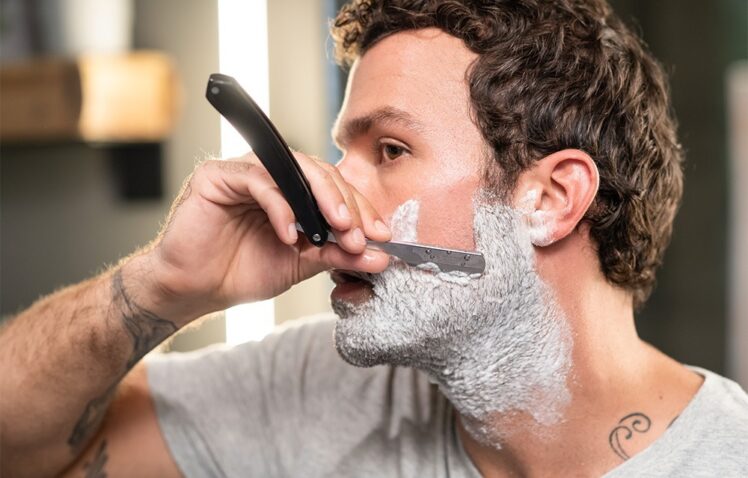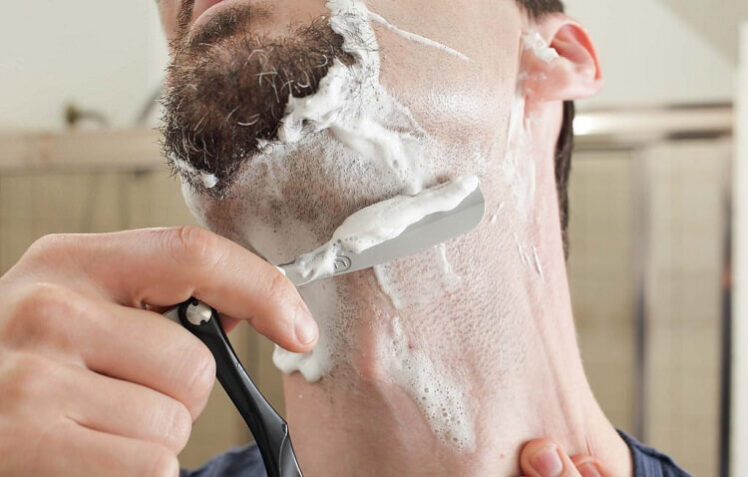Home › Style › Beards
7 Common Face Shaving Mistakes to Avoid
Published on:
With the beard slowly drifting out of style, more and more men are returning to the wet shave. Sadly, face shaving is not everyone’s area of mastery. In fact, it is near impossible to find someone who shaves frequently and hasn’t cut or hurt themselves in some way with a razor.
This article discusses some of the most common face shaving mistakes men make and how to avoid them. Hopefully, it will enhance your shaving skills and help you get around your fear of the razor.

Mistake #1: Dry shaving
Smooth and soft, facial skin is not a big fan of the razor, especially if you shave without water. Dry shaving prompts you to use more force than you should and is likely to cause irritation. It also increases your risk for cuts and nicks, which might develop into long-term scars if you keep on with your unhealthy shaving habits.
The most advisable thing to do is to avoid dry shaves at all costs. If you have to do it, make sure to use a new premium shaving razor with 4-5 sharp blades. Prepare your skin by applying a moisturizer or waterless shaving cream, and shave gently with the hair’s grain, even if this might take more time than going against the grain.
Mistake #2: Not preparing your skin
Even a wet shave won’t shield your skin from cuts, nicks, scars, and irritation if you don’t adhere to a meticulous pre-shave ritual. Poor preparation is one of the most common culprits behind after-shave irritation.
While this is common knowledge to most men, only a few know and abide by a proper preparation regimen. Here are a few things that can transform your results:
- Using hot water. Hot water softens the hairs and washes off dead skin that might get in the way of a uniform shave.
- Applying pre-shave lotion or balm. Balms and lotions expedite the softening effect and will come in mighty handy if you have a tough, wiry stubble.
- Using pre-shave oil. Pre-shave oils complement hot water and offer additional lubrication for an effortless shave.
It is impossible to do too much when it comes to pre-shave preparation, so don’t shy from doing more if you reckon your skin is not ready yet.

Mistake #3: Shaving against the grain
Going with the flow of the grain can be frustrating as it requires several razor strokes per area and draws out the shaving process. However, it protects you from irritation, burns, and cuts, which are all products of forceful hair and dead skin removal.
To find your grain, stroke your hair strands in one direction, and then the other using your finger. Do it both vertically and horizontally, and don’t assume all areas of your face have the same grain. The direction that feels smoother is “with the grain,” while the opposite one is “against the grain.”
Mistake #4: Using the same razor for too long
Dragging a dull, overused razor on your skin is the easiest way to cancel out your pre-shave preparation efforts and expose yourself to irritation, cuts, nicks, acne, infections, and ingrown hairs. Worn out razors with blunt blades require more effort to produce the clean shave you’re looking for and tend to cause razor burn.
While it is crucial to purchase a proper multiple-bladed razor in your toolkit, you have to keep in mind that even the highest-rated premium straight razors on the market cannot retain their sharpness forever. The American Academy of Dermatologists recommends that you replace your razor after 5-7 shaves, and that’s if you use it regularly and store it properly. Cheap products may wear through sooner, so it’s best that you pay close attention to performance after every shave for good measure.

Mistake #5: Using alcohol-based after-shave
Alcohol-based aftershaves are significantly more popular than their alcohol-free counterparts thanks to the antiseptic properties of alcohol, which help heal razor cuts and halt infections in their infancy. However, alcohol takes out all the hydration from your skin, potentially kick-starting other post-shave issues that balms, moisturizers, and gels don’t expose you to.
What’s more, you’re not shaving with a butcher’s knife, are you? If you can keep from hurting yourself, you won’t need alcohol-based aftershave. It’s also worth noting that some alcohol-free products contain natural ingredients such as Shea Butter and Calendula, which, too, have antiseptic properties.
Mistake #6: Shaving with body wash
Just because they both lather doesn’t mean they work the same. Body wash and ordinary soap remove dirt and oil from the skin by forming thin films around the particles. When shaving, it is not just dirt you want to remove.
You also need to lubricate and hydrate your skin, as well as protect the open pores from clogging with dirt and potentially picking up infections. These slippery agents and hydrating properties are only present in shaving cream.

Mistake #7: Reckless razor storage
Your razor won’t last forever, but you can increase its life and ensure your safety by storing it properly between- shaves.
The worst you can do to your skin is touch it with a razor that was stored in a warm, moist place. Moist -environments are conducive for rust formation, and a rusty razor exposes you to infections if you accidentally cut yourself while shaving.
Your razor will also wear out quickly and force you to prematurely invest in a replacement. If possible, buy and use a new shaving razor each time.
Mistake #7: Pressing hard on your skin
The idea is to use as few razor strokes as possible on your skin. That shouldn’t be achieved through force. The harder your press on your skin, the likelier you are to cut yourself. Light touches do the job better. More to the point, today’s blades are flexible and will seamlessly glide over the various contours of your face. In words of one syllable, less is more.

Conclusion
Getting a close shave is often easier said than done. So much goes into it, and being in possession of the right skills and tools is the only way to achieve perfection. Avoid the above mistakes for a close, clean shave devoid of cuts, dryness, irritation, and infections.
Share With Your Friends